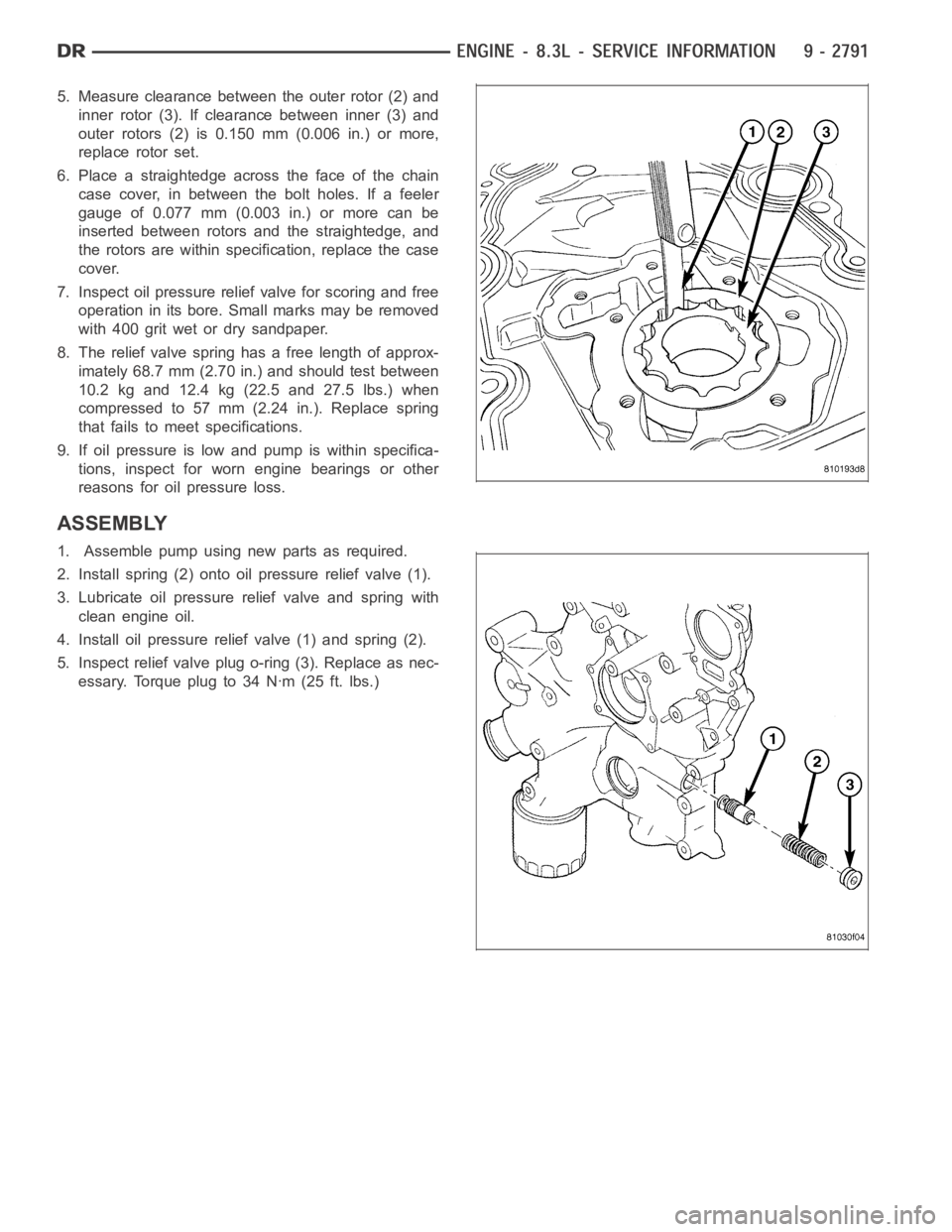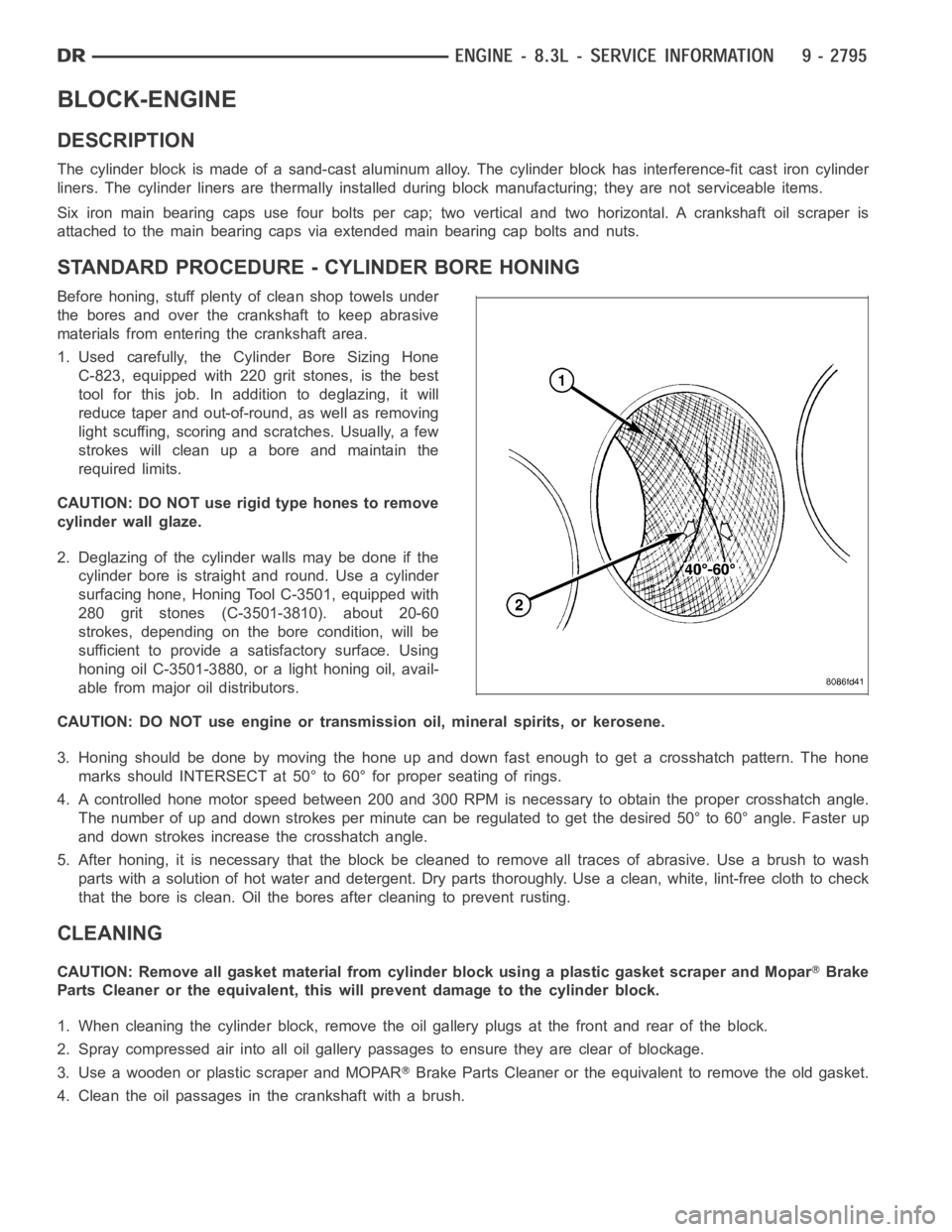Page 2094 of 5267
11. Using lifting fixture TOOL 9363 and support TOOL , raise the front of theengine
12. Remove transmission to oil pan fasteners.
13. Remove oil pan bolts and remove oil pan.
NOTE: Clean and inspect oil pan gasket. The pan gasket can be used again if ingood condition.
INSTALLATION
1. Clean gasket surfaces.Inspect oil pan gasket. Replace as necessary.
Page 2095 of 5267
2. Apply an 1/8 in. bead of Mopar Engine RTV at the two joints between the cylinder block to timing chain case
cover and the two joints between the rear main seal retainer and engine block.
3. Position oil pan and gasket to engine block, seat the oil level indicatortube in the oil pan and hand start all
fasteners.
4. Tighten the transmission to oil pan bolts in finger
tight.
5. Torque 5/16-18 oil pan bolts to 23 Nꞏm (200 in.
lbs.). Torque 1/4-20 oil pan bolts to 11 Nꞏm (95 in
lbs.).
6. Torque transmission to oil pan bolts to 23 Nꞏm (200
in. lbs.).
7. Lower the engine.
8. Install and tighten engine mount through bolts to
102 Nꞏm (75 ft. lbs.).
9. Install flywheel inspection cover.
Page 2096 of 5267
10. Install frame front cross member (Refer to 13 -
FRAME & BUMPERS/FRAME/FRONT CROSS-
MEMBER - INSTALLATION).
11. Lower vehicle.
12. Install the oil level indicator tube fastener.
13. Fill the crankcase with the correct oil to proper
level.
14. Start the engine and inspect for leaks.
Page 2097 of 5267
PUMP-OIL
REMOVAL
NOTE: The oil pump is serviced with the timing
chain cover.
1. Remove timing chain cover (1) (Refer to 9 -
ENGINE/VALVE TIMING/TIMING CHAIN COVER -
REMOVAL).
2. Disassemble oil pump (3) (Refer to 9 - ENGINE/
LUBRICATION/OIL PUMP - DISASSEMBLY).
3. Inspect oil pump parts (Refer to 9 - ENGINE/LU-
BRICATION/OIL PUMP - INSPECTION).
DISASSEMBLY
1. Remove oil pump cover screws (1) and lift off
cover.
2. Remove pump rotors.
Page 2100 of 5267

5. Measure clearance between the outer rotor (2) and
inner rotor (3). If clearance between inner (3) and
outer rotors (2) is 0.150 mm (0.006 in.) or more,
replace rotor set.
6. Place a straightedge across the face of the chain
case cover, in between the bolt holes. If a feeler
gauge of 0.077 mm (0.003 in.) or more can be
inserted between rotors and the straightedge, and
the rotors are within specification, replace the case
cover.
7. Inspect oil pressure relief valve for scoring and free
operation in its bore. Small marks may be removed
with 400 grit wet or dry sandpaper.
8. The relief valve spring has a free length of approx-
imately 68.7 mm (2.70 in.) and should test between
10.2 kg and 12.4 kg (22.5 and 27.5 lbs.) when
compressedto57mm(2.24in.). Replace spring
that fails to meet specifications.
9. If oil pressure is low and pump is within specifica-
tions, inspect for worn engine bearings or other
reasons for oil pressure loss.
ASSEMBLY
1. Assemble pump using new parts as required.
2. Install spring (2) onto oil pressure relief valve (1).
3. Lubricate oil pressure relief valve and spring with
clean engine oil.
4. Install oil pressure relief valve (1) and spring (2).
5. Inspect relief valve plug o-ring (3). Replace as nec-
essary. Torque plug to 34 Nꞏm (25 ft. lbs.)
Page 2101 of 5267
6. Install pump rotors with chamfer side to the inside
of chain case cover.
7. Install oil pump cover and screws (1). Tighten
cover screws to 23 Nꞏm (200 in. lbs.).
8. Prime oil pump before installation by filling rotor
cavity with engine oil.
INSTALLATION
1. Assemble oil pump (3) (Refer to 9 - ENGINE/LU-
BRICATION/OIL PUMP - ASSEMBLY).
2. Prime oil pump before installation by filling rotor
cavity with the correct engine oil.
3. Install timing chain cover (Refer to 9 - ENGINE/
VALVE TIMING/TIMING CHAIN COVER - INSTAL-
LATION).
4. InstallNEWoil filter.
5. Fill the crankcase with the correct engine oil to the
proper level.
Page 2104 of 5267

BLOCK-ENGINE
DESCRIPTION
The cylinder block is made of a sand-cast aluminum alloy. The cylinder block has interference-fit cast iron cylinder
liners. The cylinder liners are thermally installed during block manufacturing; they are not serviceable items.
Six iron main bearing caps use four bolts per cap; two vertical and two horizontal. A crankshaft oil scraper is
attached to the main bearing caps via extended main bearing cap bolts and nuts.
STANDARD PROCEDURE - CYLINDER BORE HONING
Before honing, stuff plenty of clean shop towels under
the bores and over the crankshaft to keep abrasive
materials from entering the crankshaft area.
1. Used carefully, the Cylinder Bore Sizing Hone
C-823, equipped with 220 grit stones, is the best
tool for this job. In addition to deglazing, it will
reduce taper and out-of-round, as well as removing
light scuffing, scoring and scratches. Usually, a few
strokes will clean up a bore and maintain the
required limits.
CAUTION: DO NOT use rigid type hones to remove
cylinder wall glaze.
2. Deglazing of the cylinder walls may be done if the
cylinder bore is straight and round. Use a cylinder
surfacing hone, Honing Tool C-3501, equipped with
280 grit stones (C-3501-3810). about 20-60
strokes, depending on the bore condition, will be
sufficient to provide a satisfactory surface. Using
honing oil C-3501-3880, or a light honing oil, avail-
able from major oil distributors.
CAUTION: DO NOT use engine or transmission oil, mineral spirits, or kerosene.
3. Honing should be done by moving the hone up and down fast enough to get a crosshatch pattern. The hone
marks should INTERSECT at 50° to 60° for proper seating of rings.
4. A controlled hone motor speed between 200 and 300 RPM is necessary to obtain the proper crosshatch angle.
The number of up and down strokes per minute can be regulated to get the desired 50° to 60° angle. Faster up
and down strokes increase the crosshatch angle.
5. After honing, it is necessary that the block be cleaned to remove all traces of abrasive. Use a brush to wash
parts with a solution of hot water and detergent. Dry parts thoroughly. Usea clean, white, lint-free cloth to check
that the bore is clean. Oil the bores after cleaning to prevent rusting.
CLEANING
CAUTION: Remove all gasket material from cylinder block using a plastic gasket scraper and MoparBrake
Parts Cleaner or the equivalent, this will prevent damage to the cylinder block.
1. When cleaning the cylinder block, remove the oil gallery plugs at the front and rear of the block.
2. Spray compressed air into all oil gallery passages to ensure they are clear of blockage.
3. Use a wooden or plastic scraper and MOPAR
Brake Parts Cleaner or the equivalent to remove the old gasket.
4. Clean the oil passages in the crankshaft with a brush.
Page 2105 of 5267
INSPECTION
The cylinder walls should be checked for out-of-round
and taper with Special Tool C-119 (1). If the cylinder
walls are badly scuffed or scored, the cylinder bore
can be machined oversize. Oversize piston and rings
are available.
Measure the cylinder bore at three levels in directions
A and B. Top measurement should be 12 mm (0.50
in.) down and bottom measurement should be 12 mm
(0.50 in.) up from bottom of bore. (Refer to 9 -
ENGINE - SPECIFICATIONS) for cylinder bore and
piston specifications.